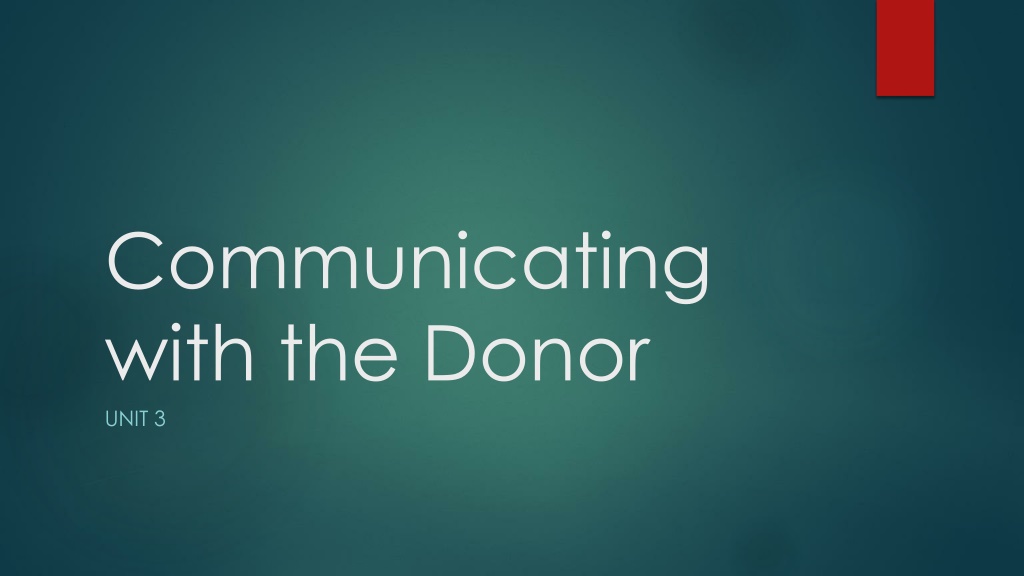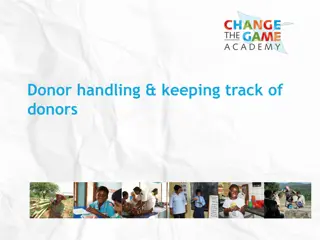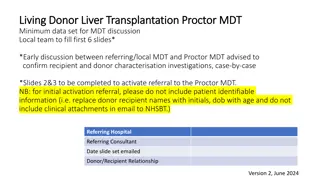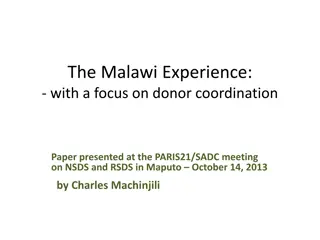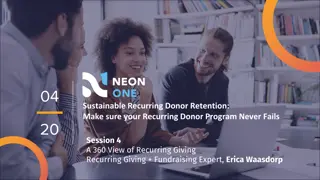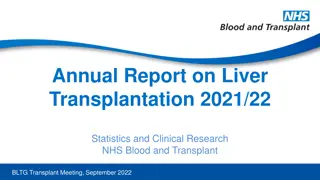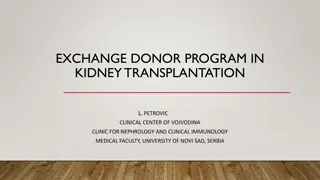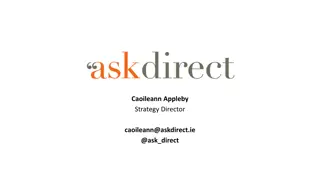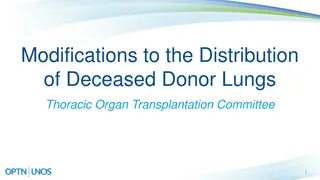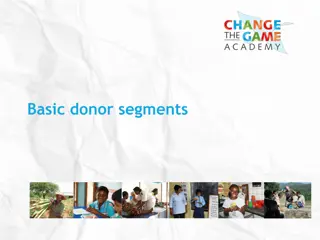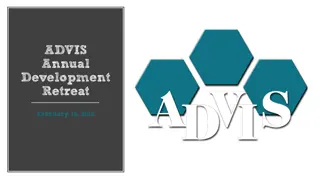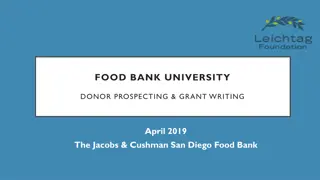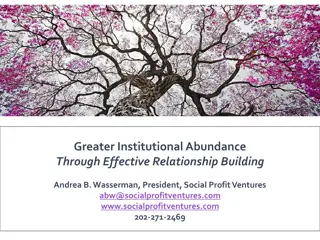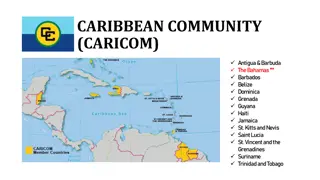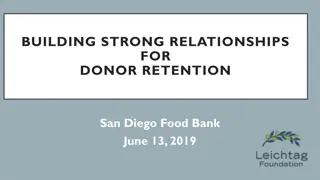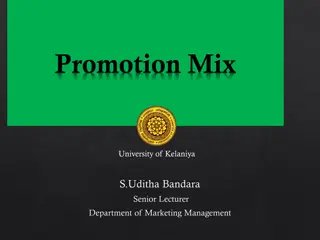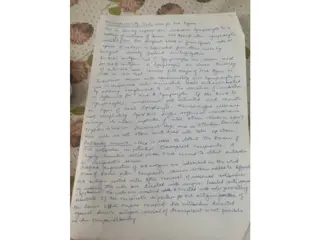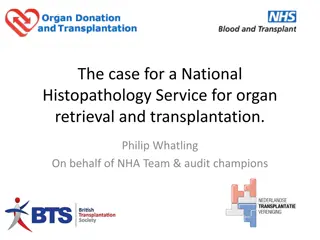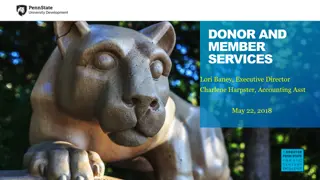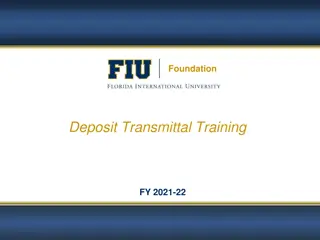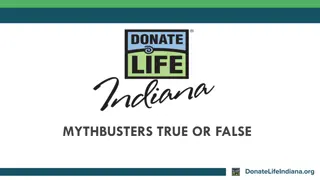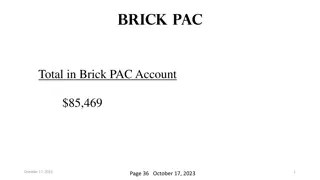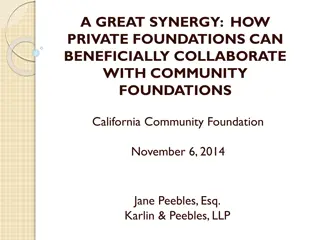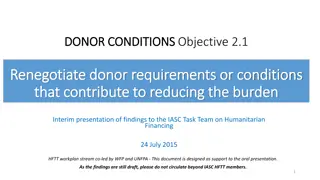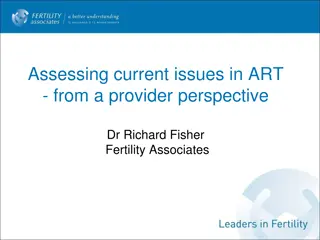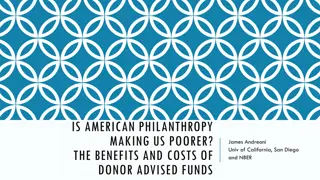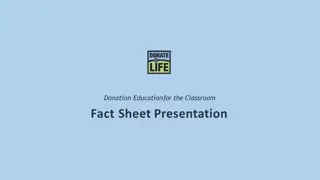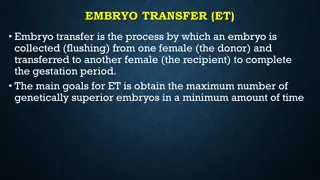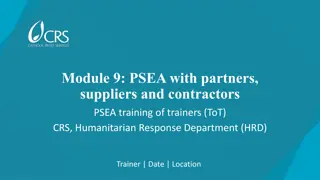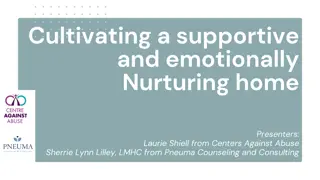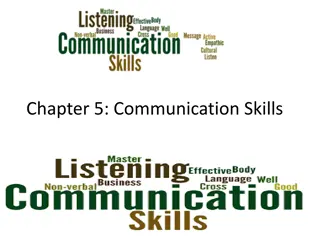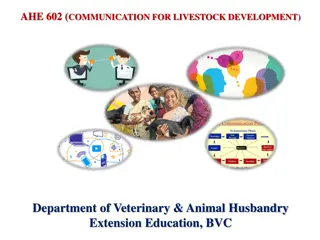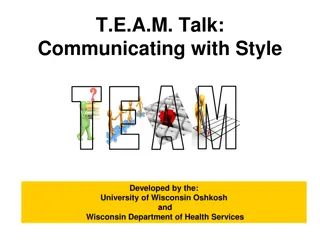Effective Communication Strategies for Donor Engagement
Understanding the levels of communication in donor engagement is crucial for nonprofits. From large group presentations to one-on-one interactions, each level serves a unique purpose in nurturing relationships with donors. Tailoring communication based on the donor's level of engagement can lead to more meaningful interactions and long-term commitment. Utilize different communication methods effectively to convey your organization's vision, values, and impact, ultimately fostering stronger connections with donors.
Download Presentation

Please find below an Image/Link to download the presentation.
The content on the website is provided AS IS for your information and personal use only. It may not be sold, licensed, or shared on other websites without obtaining consent from the author. Download presentation by click this link. If you encounter any issues during the download, it is possible that the publisher has removed the file from their server.
E N D
Presentation Transcript
Communicating with the Donor UNIT 3
3.2.1-7 What we communicate Ourselves The Vision The CEO The organisation The results Teaching on mission and other issues Concern for the donor
3.3.1-2 Levels of communication There are different levels of communication Demarcation according to size large, small, one-to-one Demarcation according to engagement new, volunteers and prayer partners, donors and long-term committed donors
3.3.3-9 Chart on Levels of Communication to levels of engagement Level New Low Donor Commited Mass Yes Yes Some times No Small Some times Yes Yes Some times One-to-one No Some times Yes Yes
3.3.3 Large group Used at the first level of engagement mainly More efficient in terms of time than using other forms Can be used for volunteers and prayer partners also Response cards needs to be made available to know who wants to raise their level of engagement
3.3.4 Small Groups Usually used when a committed donor invites his friends and contacts to hear you out Effective mainly at the second level of engagement where the people have shown some interest Can be used effectively for special presentations and reports to donors
3.3.5 One to One Time consuming and so not used except where results are proven Hence mainly used at the third and fourth level only Can be used at other levels
3.3.6 First level of engagement We present the highlights of the ministry The presentations are inspirational Presents needs, solutions and success stories
3.3.7 Second level of engagement We move from inspirational to an intellectual presentation which is also inspiring Arguments for the choice of strategy and selecting between solutions are presented We present the organization and its personnel also with the ministry Opportunity for a Question and Answer session also needs to be there
3.3.8 Third level of engagement At this level we are teaching and so speak of the theological and philosophical underpinnings of the ministry We make a strong presentation of the organization, its culture of efficiency and accountability Our presentation of success stories are not just mere narratives but arguments for the correctness of our approach and this must be brought out
3.3.9 Fourth level of engagement Here we are no longer selling the ministry We are forging strong friendships The conversation is more about the donor and his dreams and wishes Introspection of the ministry and its struggles can also be done
3.4.1-14 Aiming for the heart We draw pictures and use words which express feelings Hence easiest with ministries which have an emotional appeal and more difficult for Bible schools etc. Use words which portray reality rather than theory Face to face presentations with beneficiaries and missionaries helps Field trips are very helpful Linking donors to beneficiaries helps this Making donors into volunteers
3.4.14 Involvement with the Planning and Organizational Development We can invite suitable donors to be on the Board By giving donors a say in the ministry we increase their emotional involvement Or we can invite them to be consultants
3.5.1-10 Aiming at the head Here the presentation is teaching rather than inspiring Look for a teaching environment Use word pictures but also provide hard data Any teaching methodology is helpful power point presentations, group discussions, question an answer sessions etc. Our life needs to reflect the beliefs we present to the donors
3.6.1-2 Charismatic Fund Raising Charisma comes from people s perception that you are trustworthy This comes because you are seen to have knowledge and a trustworthy character The communication style is very similar to head centred fund raising but the content differs The content is more on showcasing and sharing our expertise for the donor s growth in knowledge The content is more on showcasing our sacrifices and commitment to the work to challenge the donor spiritually
3.6.4.1-7 The fund raiser The fund raiser must dress appropriately He must be seen to be efficient in his dealings with the donor He must be seen to be reliable maintaining schedules and promises made to the donor He must know as much as is possible about the ministry he is raising funds for He must have a genuine love, commitment, and concern for the donor
3.6.7.1-4 Presenting the CEO Speak of his/her vision and commitment Have stories about the CEO Powerful statements made by the CEO must be available with the fund raiser to quote The CEO must be seen to be an expert on his ministry and should be visible to the world as a speaker on the subject He should write on the subject bringing out books and articles
3.6.8.1-5 Presenting the organisation Train the staff so that the organization is the leading thinker in the field Hire outstanding people Have effective control systems so that information is easily available for the donor All interaction with the donor must reflect efficiency. Since efficiency is a culture it must permeate all areas of the organization
3.7.1 The practice of Fund Raising Get control of your data Get control of your presentation Develop a communication plan
3.7.2.1-5 Clarifying the vision Regularly brain storm the vision and mission statements with ALL the staff and volunteers The questions discussed would be Who are the beneficiaries being targeted by the project? What is the basis for selecting these beneficiaries? Does the strategy spelt out ensure that the targeted people are reached? What are the real needs of the beneficiaries? What needs will the aid given meet Etc.
3.7.3.1-5 Preparing the presentation Brochures and posters for mass presentations These are high in pictures and low on words Information booklets on the ministry These have more words and are heavier in content. But they need to have a good amount of pictures also Power point presentations of variable length depending on the time available All these need to be done professionally
3.7.3.6-8 Study the audience The presentation is tailor made for the audience So I need to know the audience, their interest and knowledge level etc. Where a study of the audience has not been done use Question and Answer sessions to find out about the audience In one to one situations use listening techniques to learn about the donor
3.7.3.9-18 What we present Apart from the ministry we need to present about the organization and its CEO and staff as discussed earlier We give a clear challenge at the end The first option we present is to come and visit the ministry and the field If the donor visits the ministry or indicates that he cannot visit, then we make the ask for an investment We use the term investment rather than donation We do not ask for money but for an investment in the kingdom of God
3.7.4-5 Follow Up communication Here we are not trying to create interest in the ministry but to bolster confidence in the ministry So we give results in terms of statistics and testimonies We give teaching on mission issues which affect our ministry We give teaching on ground realities so their understanding of the ministry grows We discuss philosophical issues on mission and our response to God
3.7.4.6 Showing concern We show concern for the donor by praying systematically for them We remember important events and concerns they have We make visits and phone calls on important occasions
3.8.1 Instruments Monthly Letter Prayer letters Cards Visits Formal presentations Social Media
3.8.2 Monthly Letter & Prayer letters Most send news letter It needs to communicate not only news but also ideas as listed earlier Each and every item carried should relate to the ministry No sermons or teaching not related to the ministry Prayer letters need to be genuine and not indirect asks for money
3.8.3 Visits Try and visit every donor at least once a year. Where a physical visit is not possible a telephonic visit should be done Meeting with them at events is also useful and can result in one-to- one visits over tea or coffee
3.8.4 Systematic and planned Maintain an effective database of contacts Have clarity on the vision among all the people Design the written presentations such as brochures etc. based on the intended audience Have a communication plan
